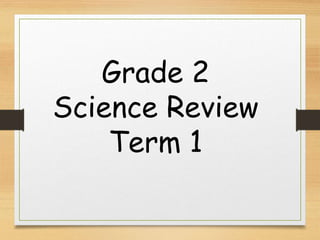
Grade 2 Science Review Plants Animals Habitats
- 2. Plants are living things. • Plants need water, sunlight, air, water, space and warmth. • Plants get nutrients from the soil. • Leaves take in air and sunlight to make food. • The stem holds the plant up. • The roots hold the plant in the soil and take in water.
- 3. Plant Traits ● The way plants look or act is called a trait. Plants get many of their traits from their parent e.g. colour, stem length, leaf shape. ● Some plants have many leaves, other plants have few or no leaves.
- 4. How do plants survive in different places? ● Plants in dry places have few or no leaves. They store water in their stem. ● Plants in wet places have large leaves. ● Plants in windy places can bend.
- 6. Animals with a backbone: 1. Giraffe 2. Lion 3. Cat 4. Dog 5. Crocodile 6. Flamingo 7. Horse Animals with no backbone: 1. Octopus 2. Starfish 3. Jellyfish 4. Caterpillar 5. Spider 6. Crab 7. Bee
- 8. Mammals: • Have hair or fur • Have live babies • Mothers make milk to feed their babies • Are warm- blooded
- 9. Birds: • Have feathers • Have wings and a beak • Lay eggs • Are warm-blooded
- 10. Reptiles: • Have hard skin or scales • Lay eggs • Live on land or in water • Are cold-blooded
- 11. Fish: • Have fins and scales • Live in water • Lay eggs • Breathe with gills • Are cold-blooded
- 12. Amphibians: • Have wet skin • Live in water and on land • Have legs • Are cold-blooded
- 13. Insects: • Have 6 legs • Hard outer shell • Can walk or fly
- 14. How do animals grow and change? ● How an animal grows and changes is called it's life cycle.
- 15. Life Cycle of a Panda
- 16. Life Cycle of a Chicken
- 17. Life Cycle of a Butterfly
- 18. How do animals survive? 1. Adaptation An adaptation is a body part or a way an animal acts. ● Giraffes have long necks that help them reach leaves in the tops of trees. ● Camels have long eyelashes to protect their eyes from the sand. ● Camels can close their nostrils to stop sand from getting inside.
- 19. How do animals survive? 2. Camouflage • Camouflage is a way that animals blend into their surroundings. The colour or shape of an animal helps it hide. Camouflage helps animals hide from predators.
- 20. How do animals stay safe? ● Fish swim in a large group. ● Turtles stay safe by hiding in their shell. ● Skunks spray a bad smelling liquid to keep other animals away.
- 21. What is a habitat? ● A habitat is a place where plants and animals live. In a habitat animals find food, homes and the water they need. ● Hot and dry (desert) ● Wet and grassy (rainforest/ jungle) ● Cold and snowy (polar) ● Grassy and warm (grasslands)
- 22. What do animals get from their habitat?
- 23. Food Chains • A food chain shows the order in which living things get the food they need. • Some food chains are on land. Some are in the water. Some can be both on land and in water. • Carnivores eat other animals. • Herbivores eat plants.
- 25. Food Web • A food web is two or more food chains that are connected.
- 26. How Habitats Change Describe how the habitat has changed:
- 27. How Habitats Change • 1. Drought – little or no rain for a long time • 2. Fire • 3. Flooding • 4. People • 5. Animals
- 28. Endangered • When many of one kind of animal die and only a few are left, that animal is endangered. • Animals can become endangered when people hunt them or build on their habitats.
- 29. Fossils • A fossil is what is left of a living thing from the past. • Scientists can learn about habitats of the past from the plant and animal fossils they find. • If a fossil does not match the habitat they were found in then scientists can tell that the habitat has changed.